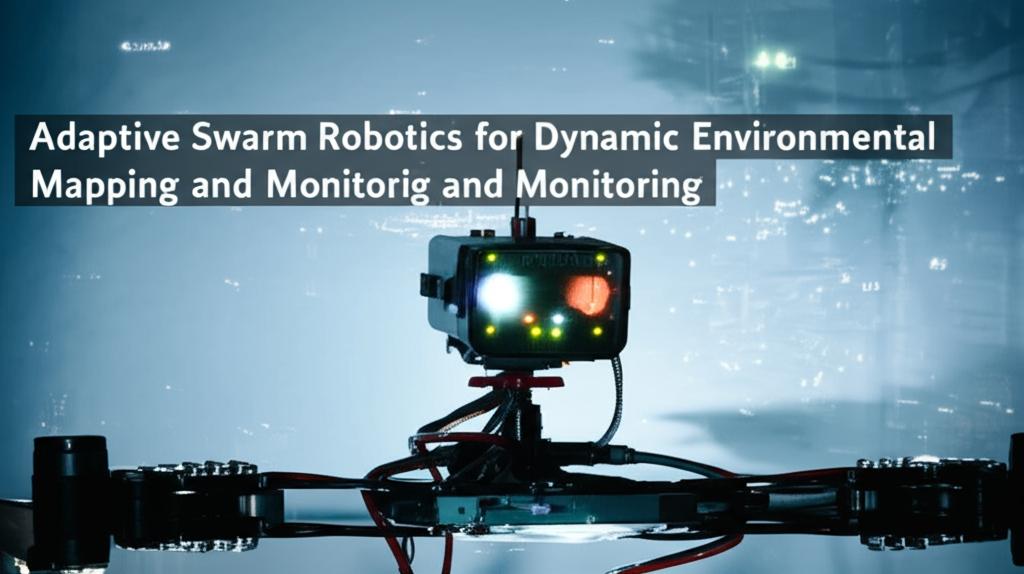The field of swarm robotics is rapidly advancing, offering innovative solutions for mapping and monitoring dynamic environments. These systems, composed of multiple, relatively simple robots, work collaboratively to gather data and create representations of their surroundings. Their decentralized nature allows for scalability, robustness, and adaptability, making them well-suited for complex and changing conditions.
Key Principles and Advantages:- Decentralized Control: Unlike traditional robotic systems that rely on a central controller, swarm robots typically operate with decentralized decision-making. This means there's no single point of failure, enhancing the system's resilience. If some robots malfunction, the swarm can often continue its mission.
- Local Interactions: Robots in a swarm primarily interact with their nearby peers and the immediate environment. This localized sensing and communication is crucial for self-organization and allows the swarm to adapt to local changes without needing global information.
- Scalability: Adding more robots to a swarm generally doesn't require reprogramming individual units or significantly altering the collective behavior. This makes it easier to deploy swarms of varying sizes depending on the task's demands, such as covering large areas for environmental monitoring or search and rescue operations.
- Adaptability and Flexibility: Swarm intelligence allows these robotic systems to adjust their collective behavior in response to new information or changes in the environment. This is vital for dynamic environmental mapping where conditions can shift unexpectedly. For instance, a swarm monitoring a forest fire can collectively identify the most urgent areas requiring attention.
- Robustness and Fault Tolerance: The redundancy inherent in a swarm system means that the failure of individual robots has a minimal impact on the overall mission. The swarm can often redistribute tasks and adapt to the loss of some units. This is particularly beneficial in hazardous or unpredictable environments.
Swarm robots employ various strategies for environmental mapping and monitoring:
- Collective Exploration and Coverage: Algorithms inspired by natural swarms, such as Ant Colony Optimization (ACO), guide robots to explore an area systematically. Virtual pheromone trails can mark explored regions, ensuring thorough coverage without excessive overlap.
- Information Sharing and Fusion: Robots share information gathered through their sensors with nearby robots. This data is then fused to build a more comprehensive and accurate map of the environment. Recent research explores the counter-intuitive idea that limiting communication range can sometimes improve the swarm's ability to adapt to new, locally observed information by preventing outdated beliefs from spreading too widely.
- Simultaneous Localization and Mapping (SLAM): Swarm SLAM is an emerging area that focuses on enabling robots to build a map of an unknown environment while simultaneously keeping track of their own positions within that map. This is a complex challenge for decentralized systems, particularly in retrieving and merging individual map data without a central point.
- Adaptive Task Allocation: In dynamic environments, tasks may appear, disappear, or change in priority. Swarm robotics systems can use methods like Optimal Mass Transport theory to dynamically assign tasks to robots, minimizing costs (e.g., travel distance) and adapting to new information in real-time.
- Behavior Adaptation: To handle unforeseen environmental changes or sensor/actuator faults, swarms can adapt their behaviors. This might involve searching through an archive of pre-programmed controllers or even developing new behaviors to optimize performance for new objectives.
- Constrained Communication for Better Adaptation: Studies suggest that shorter communication ranges can enhance a swarm's ability to adapt to new information by allowing new, locally sensed data to propagate more effectively before being overridden by older, more widespread information.
- Swarm Map-Based Bayesian Optimization: Algorithms like Swarm Map-based Optimisation (SMBO) and its decentralized version (SMBO-Dec) are being developed to enable rapid recovery from unforeseen disturbances by searching for optimal controller parameters.
- Heterogeneous Swarms: Integrating robots with different capabilities (e.g., aerial and ground robots) can expand the swarm's ability to tackle diverse monitoring tasks.
- Machine Learning and AI: Advanced AI and machine learning techniques are enhancing the robots' ability to learn from their environment, improve performance over time, and make swifter, more accurate decisions based on collected data.
- Miniaturization and Energy Efficiency: Smaller, more powerful sensors and processors, along with advances in battery technology and energy harvesting, are leading to more compact, efficient robots capable of longer-duration missions.
- Security and Reliability in Cooperative Systems: Research is focusing on developing secure incentive mechanisms and reliable cooperation strategies, often utilizing deep reinforcement learning and heuristic algorithms.
Despite significant progress, several challenges remain:
- Computational Complexity: Mapping large-scale environments can be computationally demanding. Efficient data structures, algorithms, and distributed computing approaches are crucial.
- Sensor Noise and Uncertainty: Dealing with inaccuracies in sensor readings is critical for map quality. Probabilistic techniques and sensor fusion help manage this.
- Dynamic Environments with Moving Obstacles: Effectively tracking and predicting the movement of objects in real-time is an ongoing challenge.
- Long-Term Deployment: Ensuring sustained operation in remote or harsh environments requires robust hardware, self-diagnostic and repair capabilities, and efficient energy management.
- Retrieving Global Maps: In truly decentralized swarms, efficiently retrieving a unified map from individual robot data without a central collection point is an open issue.
- Regulatory and Ethical Concerns: The deployment of swarm robotics, particularly in public or sensitive areas, raises questions about safety, privacy, and potential misuse that need to be addressed through robust regulatory frameworks.
The future of adaptive swarm robotics in environmental mapping and monitoring is promising. As technology evolves, we can expect increasingly sophisticated swarms capable of tackling even more complex tasks, from monitoring pollution levels and tracking wildlife to assisting in disaster response and sustainable agriculture. The key to unlocking their full potential lies in developing systems with greater general adaptivity, allowing them to not only adjust to different environmental conditions but also to autonomously switch between behaviors suited for a wider range of tasks.

